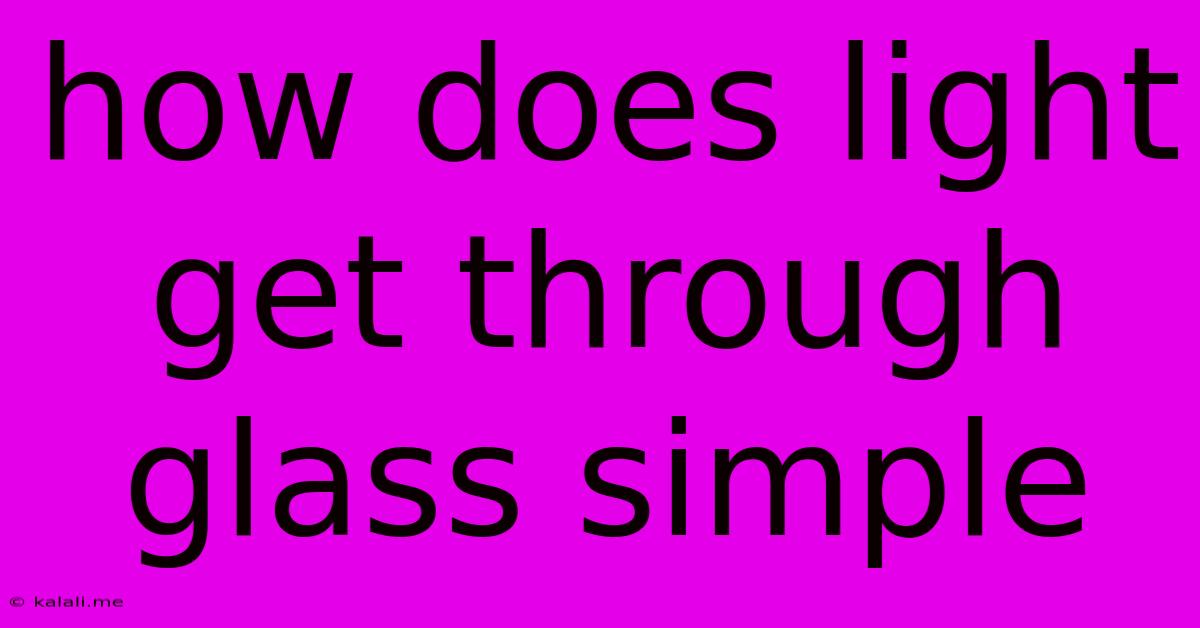How Does Light Get Through Glass Simple
Kalali
Jun 07, 2025 · 3 min read

Table of Contents
How Does Light Get Through Glass? A Simple Explanation
Meta Description: Discover the simple science behind how light passes through glass. We explain the interaction of light waves with glass molecules and why some materials are transparent while others are opaque. Learn about refraction and the fascinating world of light transmission!
Light passing through a window pane seems so simple, but the underlying physics is surprisingly fascinating. It all comes down to how light interacts with the atoms and molecules within the glass itself. Unlike many materials, glass allows light to pass through relatively unimpeded, making it transparent. But how does this happen?
The Role of Atoms and Electrons
At the heart of understanding light transmission through glass lies the behavior of its constituent atoms and their electrons. Glass is primarily made of silicon dioxide (SiO₂), arranged in a non-crystalline structure. When light, which is an electromagnetic wave, encounters these atoms, it interacts with the electrons.
The key is the energy levels of these electrons. Visible light, the part of the electromagnetic spectrum we can see, carries specific amounts of energy. The electrons in the glass molecules have energy levels that don't correspond to the energy of visible light photons. This means the electrons cannot absorb the light's energy.
Instead of being absorbed, the light waves pass through the spaces between the atoms. The light waves cause the electrons to vibrate, but these vibrations don't retain the light's energy. The energy is re-emitted as light waves, effectively continuing the light's journey through the glass. This process is known as transmission.
Why Some Materials are Opaque
In contrast to transparent materials like glass, opaque materials like wood or metal absorb or reflect light. This happens because the electrons in these materials do have energy levels that match the energy levels of visible light photons. Therefore, the light's energy is absorbed by these electrons, causing the material to heat up (in some cases), or preventing the light from passing through.
Refraction: The Bending of Light
When light passes from one medium to another (like from air to glass), its speed changes. This change in speed causes the light to bend, a phenomenon known as refraction. You can observe this when you see a straw appearing bent in a glass of water. The amount of bending depends on the refractive index of the materials involved. Glass has a higher refractive index than air, leading to this bending effect.
Different Types of Glass and Light Transmission
While we've focused on standard glass, it's important to note that different types of glass exhibit varying degrees of transparency. Certain additives or modifications can alter the light transmission properties. For instance, colored glass absorbs certain wavelengths of light, resulting in the specific color. Similarly, specialized glasses used in optical instruments are designed to optimize light transmission for their intended purposes.
Conclusion: The Transparency of Glass Explained Simply
The transparency of glass isn't a matter of empty space, but rather a sophisticated interaction between light waves and the electronic structure of its molecules. The inability of electrons in glass to absorb visible light photons allows light to pass through, with some bending due to refraction. Understanding this fundamental interaction illuminates the science behind everyday phenomena.
Latest Posts
Latest Posts
-
Can A Hot Water Heater Explode
Jun 07, 2025
-
How To Remove Pavers From A Walkway
Jun 07, 2025
-
On A Wall Power Brick Which Is Hot
Jun 07, 2025
-
How To Turn Off Imessage For One Person
Jun 07, 2025
-
How To Remove Scale Insects From Plants
Jun 07, 2025
Related Post
Thank you for visiting our website which covers about How Does Light Get Through Glass Simple . We hope the information provided has been useful to you. Feel free to contact us if you have any questions or need further assistance. See you next time and don't miss to bookmark.